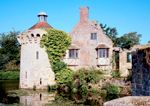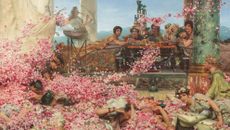Great British Garden Makers: William Sawrey Gilpin (1762-1843)
Experience as a painter enabled Gilpin to bring the Picturesque style to his clients’ landscapes


William Sawrey Gilpin (1762-1843)
William Sawrey Gilpin is rather an elusive character in the panoply of great garden-makers. For such an important designer, whose career reached its height less than 200 years ago, surprisingly little is known of him. His achievements have never been marked by a full-length biography and we do not even have a portrait of him, although he himself was a painter. As a garden-maker, Gilpin was the greatest exponent of the Picturesque style of landscaping and the man who provides the historical link between Humphry Repton and Sir Charles Barry. And he had an enormous portfolio of satisfied clients.
Gilpin set himself up as a landscape gardener very late in life. He was 58 when he started out, and he worked well into his seventies. Redundancy and unemployment were the spurs that set him on this late-flowering path towards the renown that had eluded him during his previous career. He came from a background of landscape painting, which he taught at Sandhurst young officers were required to be able to sketch a landscape quickly and accurately so that their commanding officers could decide how best to engage with enemy forces.
Experience as a painter equipped him to bring the Picturesque style to his clients' landscapes. Gilpin set up business just at the right time; Humphry Repton had died in 1818, leaving no obvious heir to his practice (apart from his incompetent sons), and the Romantic movement was getting into full swing in the early 1820s.
What is the essence of the Picturesque style? It was founded on a belief that the 18th-century English landscape style introduced by Capability Brown was too sweeping, too shapeless, too smooth, too tidy and too monotonous-and needed to be improved in two specific ways. First, the landscape should be laid out irregularly. This meant, for example, that clumps of trees should not be symmetrical, but open out in different directions on all sides.
Some of the clumps that Gilpin planted look almost like an amoeba in their irregular outlines-although he maintained that they were compositions that grouped together well and created both harmony of tints and unity of character within themselves. This desire for asymmetry was also promoted by architects of the time. Gilpin flourished just as the Gothic style became fashionable, with all its turrets, gables, battlements and pinnacles-the ‘Waverley Novels' effect.
The other fundamental precept of the Picturesque was that the picture should, in effect, be properly framed. This had many implications but, above all, that the landscape should not sweep right up to the house (we can still see examples today at such Brownian parks as Petworth in Sussex), but that the view from each of the windows of the principal rooms should be considered and improved.
Sign up for the Country Life Newsletter
Exquisite houses, the beauty of Nature, and how to get the most from your life, straight to your inbox.
Gilpin asserted that ‘composition in landscape embraces three distinct parts, the distance, the middle distance, and the foreground' but, as ‘the first of these is out of the reach of improvement in itself', the most important was the foreground, because it frames the others and should be properly dressed. The art of improvement consisted of uniting all three into one harmonious whole.
Gilpin added to many of the houses where he worked a long terrace along its principal façade, which gave a stylish frame to the landscape beyond. It had the effect of ‘softening off art into nature... in the same way that an artist softens off hardness of outline in his picture'. These terraces also provide a walk from which to admire the ever-changing sequence of prospects.
Gilpin was, by his own admission, ‘little conversant with flowers', yet he was asked in 1831 to design and plant up a formal garden to link the newly facelifted Jacobean-style house at Audley End in Essex with its Capability Brown landscape. Gilpin obliged with a parterre garden stretching out towards the Temple of Concord and composed of 170 geometric flower beds crisply cut from the turf-no yew hedges, no clipped box.
English Heritage, the present owner of Audley End, restored this remarkable garden in the 1990s and filled it with original varieties of perennials, bedding plants and annuals. It is one of the most extraordinary garden designs you will ever encounter, but if you stand on the terrace in front of the house on a midsummer morning, you will immediately see how the colourful plantings provide a firm and attractive base line for the more distant compositions.
Charles Quest-Ritson
The life and times
1762-1804 William Sawrey Gilpin was born in 1762, son of Sawrey Gilpin (1733-1807), the animal painter, and nephew of the Rev William Gilpin (1724-1804), the author of several studies of the Picturesque. He practised landscape painting, mainly in watercolours, taught in London and assisted his uncle with some of the illustrations for Observations on the River Wye (1783). He was patronised by Sir George Beaumont, who introduced him to Uvedale Price, author of Essays on the Picturesque (1794). 1804-20 He was elected the first President of the Society of Painters in Water Colours in 1804. He resigned in 1806 to become third drawing master at the Royal Military College, which moved in 1812 from Great Marlow to Sandhurst. He was made redundant, a victim of cost-cutting, in 1820. 1820-43 In need of a new livelihood, Gilpin moved to Sheen in Surrey, where his family had property, and turned to landscape gardening. Success came quickly, thanks to recommendations and introductions engineered by Uvedale (later Sir Uvedale) Price and Sir George Beaumont. In 1831, he designed a formal garden for Audley End (below) in Essex, and in 1834, he created a dramatic landscape for Scotney Castle in Kent. 1832 Gilpin's book, in which he set out the theory of ‘Picturesque' landscaping and his implementation of them was published in 1832 with the handy title of Practical hints upon landscape gardening: with some remarks on domestic architecture, as connected with scenery. The main source of Gilpin's ideas was Price's Essays on the Picturesque as compared with the Sublime and Beautiful (1794), which he sought ‘to render practically useful', but he also paid tribute to his uncle William Gilpin, whose Observations of landscapes in differ-ent parts of Britain and whose various essays provided a firm foundation for both the theory and the practice of the Picturesque. Gardens where he worked that are open to the public include Wolterton Hall (Norfolk), Clumber Park (Nottinghamshire) and Hutton-in-the-Forest (Cumbria). 1843 Gilpin died at Sedbury Hall, Yorkshire, the home of his cousin John Gilpin, on April 4, 1843, but he left little in the way of concrete evidence of his methods. The landscapes have survived, but hardly any supporting paperwork. Unlike Humphry Repton, who sold his suggestions by means of before and after views, bound and offered as his ‘red books', Gilpin didn't make a charge for his drawings; much of his work was done as on-site sketches that were discussed with his clients and their clerk of works, and discarded when the recommendations had been carried through.
Country Life is unlike any other magazine: the only glossy weekly on the newsstand and the only magazine that has been guest-edited by HRH The King not once, but twice. It is a celebration of modern rural life and all its diverse joys and pleasures — that was first published in Queen Victoria's Diamond Jubilee year. Our eclectic mixture of witty and informative content — from the most up-to-date property news and commentary and a coveted glimpse inside some of the UK's best houses and gardens, to gardening, the arts and interior design, written by experts in their field — still cannot be found in print or online, anywhere else.
-
 How many puppies in the average litter? Country Life Quiz of the Day
How many puppies in the average litter? Country Life Quiz of the DayPlus a 1960s house, Hollywood's most famous cavewoman and more in Friday's quiz.
By Toby Keel Published
-
 Love, sex and death: Our near-universal obsession with the rose
Love, sex and death: Our near-universal obsession with the roseNo flower is more entwined with myth, religion, politics and the human form than the humble rose — and now there's a new coffee table book celebrating them in all of their glory.
By Amy de la Haye Last updated
